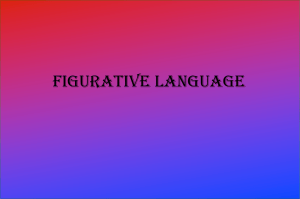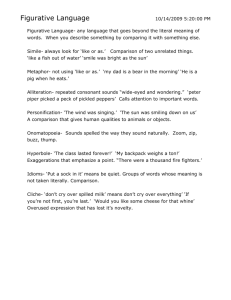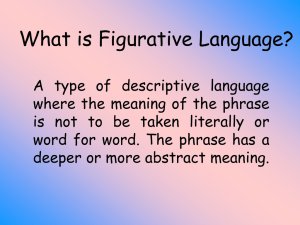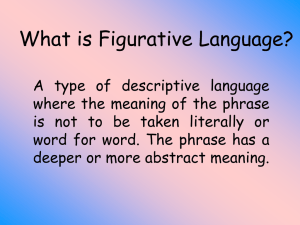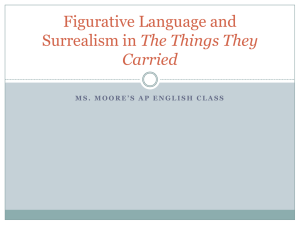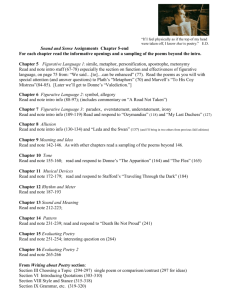Learning Objective: After exploring figurative
advertisement
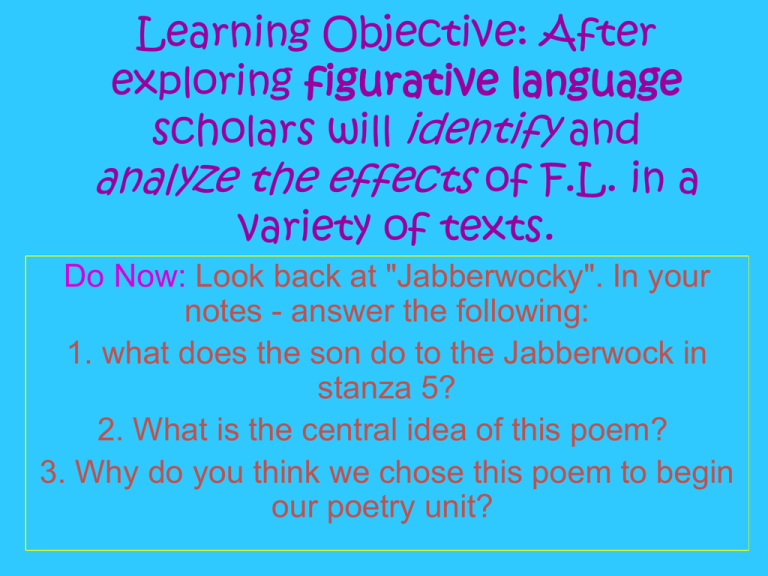
Learning Objective: After exploring figurative language scholars will identify and analyze the effects of F.L. in a variety of texts. Do Now: Look back at "Jabberwocky". In your notes - answer the following: 1. what does the son do to the Jabberwock in stanza 5? 2. What is the central idea of this poem? 3. Why do you think we chose this poem to begin our poetry unit? Poetry • According to Jacqueline Woodson, it is not “some secret language meant to confuse people.” • Expressive form of writing • Can have rules or not have rules! • Uses many examples of figurative language Figurative Language – Language that doesn’t mean exactly what you say – May help you make connections by triggering a visual or other sensory memory Types of Figurative Language • • • • • • • Simile Metaphor Personification Repetition Onomatopoeia Rhyme Alliteration Simile • A simile is a figurative language technique where a comparison is made using like or as. – Why? Provides the audience with an image to help them understand what the author is getting at. Examples of similes: • She is like a rainy day. • He is as busy as a bee. • They are like two peas in a pod. I am hungry as a horse. You run like a rabbit. She is happy as a clam. He is sneaky as a snake. Metaphor A poetic comparison that does not use the words like or as. - Why? It provides the audience with a clearer picture of an abstract concept Examples of metaphors: She is a graceful swan. He is a golden god. They are honey from the honeycomb. 7 The girl was a fish in the water. The clown was a feather floating away. Personification A figure of speech in which inanimate objects or abstractions (things that are not human) are given human qualities or are represented as possessing human form. Joyet 2004 9 The flowers danced in the wind. The friendly gates welcomed us. The Earth coughed and choked in all of the pollution. Repetition When a word, phrase, line or stanza is repeated over the course of a poem. Poets do this to show the importance of that idea. For example: First and Last stanza of “Jabberwocky” 11 Onomatopoeia • Words that are sounds • Why? – Authors use onomatopoeia to catch our attention – They also use it to appeal to our sense of hearing. Rhyme Scheme When ending sounds are alike Cat, bat, mat, sat Once there was a man named Luke who always sat in bed to puke Can be found At the end of every line (AABB) At the end of every other line (ABCB) Random Within a line (The black cat sat in a hat) 13 Alliteration • When the initial sound in a series of words is repeated – Sally sells seashells – Why did Warren wash his Wooble? – Used to make language more interested and musical Group Practice • Each group of detectives will be assigned one type of figurative language. • Your task is to find the evidence in the poems and record your answers in the detective notebook (use the chart!) The poems can be found on the following pages: 615, 619, 620, 625, 630, 631, 635, 636-637, 644-645 Share • Share your detective findings with the class. • Take notes on what you hear. How do Each of these Effect the poems? • Let’s go back into the poems and see how each type of figurative language makes the poem unique, interesting, different, etc.




